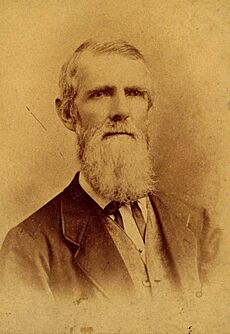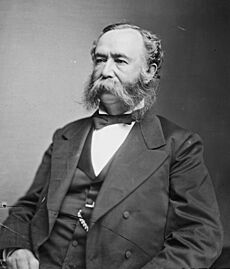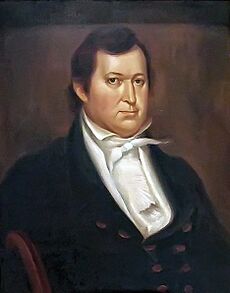Clariosophic Society facts for kids
Quick facts for kids Clariosophic Society |
|
|---|---|
| ΜΣΦ | |
| Founded | February 1806 University of South Carolina |
| Type | Literary society |
| Affiliation | Independent |
| Scope | Local |
| Chapters | 1 |
| Headquarters | Columbia, South Carolina United States |
The Clariosophic Society, also known as ΜΣΦ (Mu Sigma Phi), is a special club for students. It's called a "literary society" because its members enjoy reading, writing, and discussing ideas. This society started way back in 1806 at the University of South Carolina. Back then, the university was known as South Carolina College.
The Clariosophic Society was formed when an older student club, the Philomathic Society, decided to split into two groups. This happened in February 1806. Students voted to create two new societies. One became the Clariosophic Society, and the other was named the Euphradian Society. Two brothers helped choose which students would join each new group, a bit like picking teams for a game. John Goodwin was the first president of the Clariosophic Society. Other early leaders included Stephen Elliott, Hugh S. Legaré, George McDuffie, and Richard I. Manning. After some time, the society became active again in 2013.
Contents
Symbols of the Clariosophic Society
When new members joined the Clariosophic Society, they received a special Latin Diploma. They also used to get a unique key. This key showed that they were officially members of the society. Over time, the tradition of giving out keys stopped, but the key's design still appeared on the diplomas.
The key was shaped like a rhombus, which is a diamond shape. However, its top and bottom points were flattened. On the front of the key, there were two hearts that overlapped at the top. In the middle, you could see the Greek letters Mu Sigma Phi (ΜΣΦ). At the bottom, the initials C.S. stood for Clariosophic Society. The back of the key also had two hearts at the top. In the center, there were two Greek words starting with the letters Delta and Phi (ΔΦ). At the bottom, the initials S.C.C. stood for South Carolina College.
Famous Members of the Society
Many important people have been members of the Clariosophic Society throughout history. These members often went on to become leaders in government, law, and other fields.
Leaders from the 1800s
Many members from the 19th century became well-known. Here are a few examples:
- Preston Brooks: He later served as a U.S. Representative for South Carolina.
- Andrew Pickens Butler: He became a U.S. Senator for South Carolina.
- William Butler: He was a doctor and also served as a U.S. Representative for South Carolina.
- John C. Calhoun: A very important figure, he was an honorary member and later became the U.S. Vice President.
- William Capers: He became a bishop in the Methodist Episcopal Church, South.
- Anderson Crenshaw: He was the very first student to graduate from South Carolina College. He later became a judge on the Alabama Supreme Court.
- Stephen Elliott: He became the first Episcopal Bishop of Georgia.
- John Gayle: He was a president of the Clariosophic Society and later served as the governor of Alabama.
- William Henry Gist: He later became the governor of South Carolina.
- Wade Hampton III: A very famous member, he later served as the governor of South Carolina and a U.S. Senator.
- Hugh S. Legaré: He later became the U.S. Attorney General.
- Dixon Hall Lewis: He served as a U.S. Senator for Alabama.
- George McDuffie: He was a Clariosophic president and later became the governor of South Carolina and a U.S. Senator.
- Richard I. Manning: He also served as the governor of South Carolina and a U.S. Representative.
- John Murphy: He later became the governor of Alabama.
- Henry William Ravenel: He was a well-known botanist, someone who studies plants.
- Edwin G. Seibels: While a student, he served in the South Carolina House of Representatives. He later invented the vertical filing cabinet, which helps organize papers.
- Louis T. Wigfall: He served as a U.S. Senator for Texas.
Leaders from the 1900s
The society continued to have influential members in the 20th century:
- Robert Elliott Gonzales: He was the first editor of The Gamecock, a student newspaper, and a respected journalist.
- William Jennings Bryan Dorn: He served as a U.S. Representative for South Carolina.
- Strom Thurmond: He was the governor of South Carolina from 1947 to 1951 and a U.S. Senator for South Carolina from 1954 to 2003.
- John C. West: He was the governor of South Carolina from 1971 to 1975 and later served as the United States Ambassador to Saudi Arabia.
Resources
- Haygood, Tamara Miner (2006). Henry William Ravenel, 1814–1887 South Carolina scientist in the Civil War Era, Tuscaloosa: University of Alabama Press.
- Hollis, Daniel Walker (1951). University of South Carolina, volume I: South Carolina College, Columbia: University of South Carolina Press.





